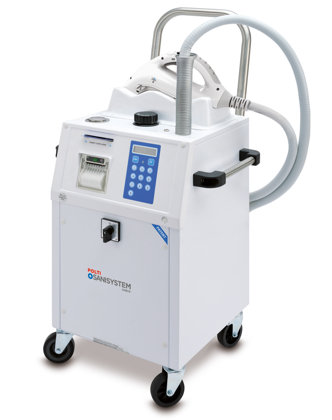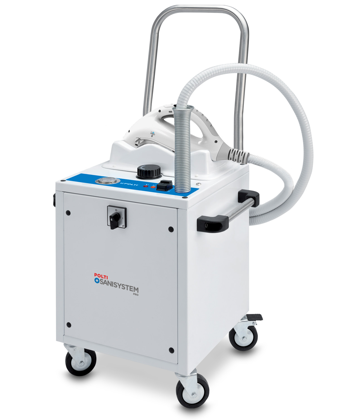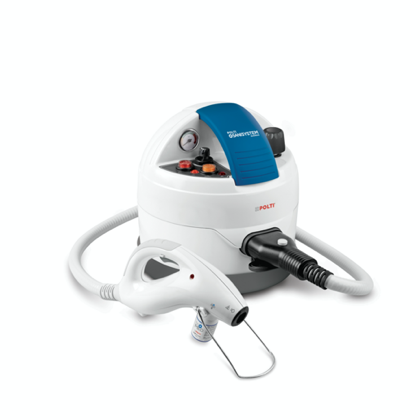The products of the Polti Sani System family are SDD – Steam Disinfection Devices.
*The products of the Polti Sani System range have been tested in compliance with the standard AFNOR NF T72-110 – medical setting
and have demonstrated virucidal, bactericidal, sporicidal, fungicidal, levurocidal and mouldicidal effects.
LIST OF TESTS:
- 08/03/2021 – Bovine Coronavirus (BcoV) – surrogate virus for SARS-related viruses (including SARS CoV-2) –
STANDARD AFNOR NF T 72-110:2019 – CHELAB Srl Laboratory – a Mérieux NutriSciences Company – Resana (TV) – Italy - 08/03/2021 – Murine Norovirus – STANDARD AFNOR NF T 72-110:2019 – CHELAB Srl Laboratory – a Mérieux NutriSciences Company – Resana (TV) – Italy
- 08/03/2021 – Adenovirus – STANDARD AFNOR NF T 72-110:2019 – CHELAB Srl Laboratory – a Mérieux NutriSciences Company – Resana (TV) – Italy
- 09/02/2021 – Bovine Coronavirus (BcoV) – surrogate virus for SARS-related viruses (including SARS CoV-2) – STANDARD AFNOR NF T 72-
110:2019 – Laboratorio Eurofins Biolab – Vimodrone (MI) – Italia - 04/02/2021 – Escherichia coli – Determination of bactericidal, fungicidal, yeasticidal and sporicidal with POLTI SANI SYSTEM – STANDARD AFNOR NF T72 110: 2019 03 – EcamRicert Srl – a Mérieux NutriSciences Company – Monte di Malo (VI)
- 04/02/2021 – Pseudomonas aeruginosa – Determination of bactericidal, fungicidal, yeasticidal and sporicidal with POLTI SANI SYSTEM –
STANDARD AFNOR NF T72 110: 2019 03 – EcamRicert Srl – a Mérieux NutriSciences Company – Monte di Malo (VI) - 04/02/2021 – Bacillus subtilis spores – Determination of bactericidal, fungicidal, yeasticidal and sporicidal with POLTI SANI SYSTEM –
STANDARD AFNOR NF T72 110: 2019 03 – EcamRicert Srl – a Mérieux NutriSciences Company – Monte di Malo (VI) - 04/02/2021 – Candida albicans – Determination of bactericidal, fungicidal, yeasticidal and sporicidal with POLTI SANI SYSTEM –
STANDARD AFNOR NF T72 110: 2019 03 – EcamRicert Srl – a Mérieux NutriSciences Company – Monte di Malo (VI) - 04/02/2021 – Aspergillus brasiliensis – Determination of bactericidal, fungicidal, yeasticidal and sporicidal with POLTI SANI SYSTEM –
STANDARD AFNOR NF T72 110: 2019 03 – EcamRicert Srl – a Mérieux NutriSciences Company – Monte di Malo (VI) - 14/07/2020 – Enterococcus hirae – Report for POLTI SANI SYSTEM BUSINESS – POLTI SANI SYSTEM GUN test –
STANDARD AFNOR NF T72 110: 2019 03 – EcamRicert Srl – a Mérieux NutriSciences Company – Monte di Malo (VI) - 10/02/2011 – Staphylococcus aureus – Verification of the bactericidal efficacy of the POLTI SANI SYSTEM in combination with the HPMED
sanitiser – Prometeo Laboratory – Bologna – Italy - 10/02/2011 – Acinetobacter baumannii – Verification of the bactericidal efficacy of the POLTI SANI SYSTEM in combination with the HPMED
sanitiser – Prometeo Laboratory – Bologna – Italy - 10/02/2011 – Pseudomonas aeruginosa – Verification of the bactericidal efficacy of the POLTI SANI SYSTEM in combination with the HPMED
sanitiser – Prometeo Laboratory – Bologna – Italy - 10/02/2011 – Klebsiella pneumoniae – Verifica dell’efficacia battericida del Sistema POLTI SANI SYSTEM in combinazione con il sanificante
HPMED – Laboratorio Prometeo – Bologna – Italia - 29/06/2010 – Total microbial load – Polti Sani System test in a real context on ambulances – San Severo Hospital – ASL Foggia – Italy
- 04/12/2009 – Human Influenza A virus (H1N1) – Report 2009/958 SAMi – Evaluation of the virucidal efficacy (H1N1) of superheated dry steam and HPMED – Eurofins Biolab Laboratory – Vimodrone (MI) – Italy
- 14/01/2009 – Staphylococcus aureus – University of Technology di Swinburne – Australia
- 14/01/2009 – Saccharomyces cerevisiae – University of Technology di Swinburne – Australia
- 14/01/2009 – Pseudomonas fluorescens – University of Technology di Swinburne – Australia
- 14/01/2009 – Escherichia coli – University of Technology di Swinburne – Australia
- 14/01/2009 – Enterococcus faecalis – University of Technology di Swinburne – Australia
- 14/01/2009 – Aspergillus Niger – University of Technology di Swinburne – Australia
- 02/05/2008 – Staphylococcus aureus meticillino-R (MRSA) – Evaluation of the bactericidal activity of superheated dry steam and HPMED against methicillin resistant Staphylococcus aureus (MRSA) – Cantonal Institute of Microbiology – Bellinzona – Switzerland
- 22/02/2008 – Escherichia coli – Evaluation of the bactericidal activity of superheated dry steam and HPMED – Cantonal Institute of Microbiology – Bellinzona – Switzerland
- 22/02/2008 – Coagulase-Negative Staphylococcus – Evaluation of the bactericidal activity of superheated dry steam and HPMED – Cantonal Institute of Microbiology – Bellinzona – Switzerland
- 22/02/2008 – Klebsiella pneumoniae – Evaluation of the bactericidal activity of superheated dry steam and HPMED – Cantonal Institute of Microbiology – Bellinzona – Switzerland
- 22/02/2008 – Proteus mirabilis – Evaluation of the bactericidal activity of superheated dry steam and HPMED – Cantonal Institute of Microbiology – Bellinzona – Switzerland
- 16/07/2007 – Staphylococcus aureus meticillino-R (MRSA) – Evaluation of the antimicrobial activity of a system of saturated steam nebulization – A.O. “San Carlo Borromeo Hospital” – Milan – Italy
- 16/07/2007 – Staphylococcus aureus meticillino-S (MSSA) – Evaluation of the antimicrobial activity of a system of saturated steam nebulization – A.O. “San Carlo Borromeo Hospital” – Milan – Italy
- 16/07/2007 – Streptococcus sanguinis – Evaluation of the antimicrobial activity of a system of saturated steam nebulization – A.O. “San Carlo Borromeo Hospital” – Milan – Italy
- 16/07/2007 – Streptococcus agalactiae – Evaluation of the antimicrobial activity of a system of saturated steam nebulization – A.O. “San Carlo Borromeo Hospital” – Milan – Italy
- 16/07/2007 – Streptococcus pneumoniae – Evaluation of the antimicrobial activity of a system of saturated steam nebulization – A.O. “San Carlo Borromeo Hospital” – Milan – Italy
- 16/07/2007 – Streptococcus pyogenes – Evaluation of the antimicrobial activity of a system of saturated steam nebulization – A.O. “San Carlo Borromeo Hospital” – Milan – Italy
- 16/07/2007 – Nocardia asteroides – Evaluation of the antimicrobial activity of a system of saturated steam nebulization – A.O. “San Carlo Borromeo Hospital” – Milan – Italy
- 16/07/2007 – Nocardia farcinica – Evaluation of the antimicrobial activity of a system of saturated steam nebulization – A.O. “San Carlo Borromeo Hospital” – Milan – Italy
- 16/07/2007 – Enterococcus faecalis – Evaluation of the antimicrobial activity of a system of saturated steam nebulization – A.O. “San Carlo Borromeo Hospital” – Milan – Italy
- 16/07/2007 – Enterococcus faecium – Evaluation of the antimicrobial activity of a system of saturated steam nebulization – A.O. “San Carlo Borromeo Hospital” – Milan – Italy
- 16/07/2007 – Campylobacter Spp – Evaluation of the antimicrobial activity of a system of saturated steam nebulization – A.O. “San Carlo Borromeo Hospital” – Milan – Italy
- 16/07/2007 – Escherichia coli – Evaluation of the antimicrobial activity of a system of saturated steam nebulization – A.O. “San Carlo Borromeo Hospital” – Milan – Italy
- 16/07/2007 – Klebsiella oxytoca – Evaluation of the antimicrobial activity of a system of saturated steam nebulization – A.O. “San Carlo Borromeo Hospital” – Milan – Italy
- 16/07/2007 – Serratia marcescens – Evaluation of the antimicrobial activity of a system of saturated steam nebulization – A.O. “San Carlo Borromeo Hospital” – Milan – Italy
- 16/07/2007 – Proteus mirabilis – Evaluation of the antimicrobial activity of a system of saturated steam nebulization – A.O. “San Carlo Borromeo Hospital” – Milan – Italy
- 16/07/2007 – Salmonella enterica – Evaluation of the antimicrobial activity of a system of saturated steam nebulization – A.O. “San Carlo Borromeo Hospital” – Milan – Italy
- 16/07/2007 – Pseudomonas aeruginosa – Evaluation of the antimicrobial activity of a system of saturated steam nebulization – A.O. “San Carlo Borromeo Hospital” – Milan – Italy
- 16/07/2007 – Stenotrophomonas maltophilia – Evaluation of the antimicrobial activity of a system of saturated steam nebulization – A.O. “San Carlo Borromeo Hospital” – Milan – Italy
- 16/07/2007 – Haemophilus influenzae – Evaluation of the antimicrobial activity of a system of saturated steam nebulization – A.O. “San Carlo Borromeo Hospital” – Milan – Italy
The virucidal efficacy was assessed according to the French regulation AFNOR NF T 72-110: 2019 (Method of disinfection of surfaces by steam with or without contact – Determination of bactericidal, fungicidal, levurocidal, sporicidal and virucidal activity).
On the basis of the results obtained, in the experimental condition adopted, the product under examination causes a reduction greater than or equal to 4.39 Log (99.99%) against Bovine Coronavirus* (BCoV) RVB-0020 with 1 application of continuous steam with a pass at a speed of 10 cm/sec and at a distance of 5 mm from the surface.
Considering that:
to other Coronaviruses;
for example from 150° to 160°C due to the heat and the deactivation speed for each log is minimal, quantifiable
as about 0.1 second;
and the log deactivation speed is approximately 10 seconds;
by dry steam;
It can be said that the steam treatment of Polti equipment must be considered effective in completely deactivating the SARS-CoV2 virus at a temperature of 80°C or higher. With the very high temperatures reached by Polti Sani System, deactivation is effective in very short exposure times (a few seconds).
CHELAB Srl Laboratory – a Mérieux NutriSciences Company – Resana (TV) – Italy
According to the guidelines of the NF T72-110: 2019-03 standard, in the applied test conditions, the product in question “SDD” has a virucidal effect against Bovine Coronavirus* since the viral reduction of the tested strain is > 4 Log.
*Bovine coronavirus is used as a surrogate virus for SARS-related viruses (including SARS CoV-2) as it belongs to the same genre as Betacoronavirus 1, with a similar morphology and size, but at a Bio Safety Level 2.
The bactericidal, sporicidal, fungicidal, levurocidal efficacy was assessed according to the French regulation AFNOR NF T 72-110: 2019 (Method of disinfection of surfaces by steam with or without contact – Determination of bactericidal, fungicidal, levurocidal, sporicidal and virucidal activity).
The test product used in the experimental condition adopted causes reduction greater than or equal to:
With 1 application of continuous steam with a pass at a speed of 10 cm/sec and at a distance of 5 mm from the surface.
Virucidal efficacy was assessed according to European standard EN 14476 (quantitative test in suspension for the evaluation of virucidal activity in the medical area).
Based on the results obtained, in the experimental condition adopted, the product under examination causes a reduction greater than or equal to 4 Log (99.99%) against Human Influenza A (H1N1) after 15 seconds.
Sanitisation has proved effective for the disinfection of a work surface previously contaminated with the following microorganisms: Escherichia coli, Staphylococcus coagulase negative, Klebsiella pneumoniae and Proteus mirabilis. After the treatment, no bacterial growth was found on the surfaces.
The evidence shows that the product concerned kills 100% of the eggs and 90% of the adult bed bugs at the first pass. In the field tests it completely eliminated the Cimex infestation with between two and three treatments, also successfully degrading the sticky substance that binds the eggs to the surfaces, reducing the smell of bedbugs and eliminating the traces of excrement thanks to the combined use of steam and HPMED.
The bactericidal activity on two strains of Methicillin Resistant Staphylococcus Aureus (MRSA) was analysed on different surfaces.
Use for 30 seconds proved effective for the sanitisation of various materials, including stainless steel and melamine
coatings, with a reduction in the bacterial load of 4 logarithms, while as regards ceramics, a bacte-rial residue was found only for the most resistant MRSA strain (3 logarithms).
This type of test demonstrates a reduction in the bacterial load of 4 log and therefore a reduction of up to
99.99%.
The product concerned showed activity on several Gram positive and Gram negative bacteria and on different types of fungi. Antimicrobial activity has been found on inert equipment, environments and materials such as plastic, metal and glass. Preliminary tests carried out on inert materials demonstrated a significant reduction of up to 99.999% of the tested species.
Under standard operating conditions, the sanitisation carried out caused a reduction in the total microbial load of 91.6%, compared with 88.8% with the traditional method of sanitisation (using chemical products).
30 seconds of treatment with superheated dry steam and HPMed proved effective in reducing the microbial load by 99.999% for Gram positive, Gram negative, filamentous fungi and yeasts. 30 seconds of treatment reduced the spores by 97%.
Experimentation in a real context shows that this is a valid method for sanitising ambulances because it drastically reduces the total microbial load present on surfaces.
A range of products for steam disinfection

Sani System Check

Sani System Pro

Sani System Business
 - Portugal
- Portugal - Italia
- Italia - International
- International - France
- France - España
- España - United Kingdom
- United Kingdom - Deutschland
- Deutschland
